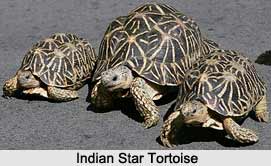 Indian Star Tortoise is an Indian Reptile that bears a scientific name "Geochelone elegans" has the wide habitat in Indian states like Telangana, Andhra Pradesh, Odisha and the coastal part of Eastern Ghats Mountain Range in India.
Indian Star Tortoise is an Indian Reptile that bears a scientific name "Geochelone elegans" has the wide habitat in Indian states like Telangana, Andhra Pradesh, Odisha and the coastal part of Eastern Ghats Mountain Range in India.
Concentration of Indian Star Tortoise
Indian Star Tortoise is a species of tortoise, which are found in dry areas and scrub forest in India and Sri Lanka.
Structure of Indian Star Tortoise
The carapace of Indian star tortoise (Geochelone elegans) is very convex, with dorsal shields often forming humps; the lateral margins are nearly vertical; the posterior margin is somewhat expanded and strongly serrated. It has no nuchal scute, and the supracaudal is undivided and curved inward in the male. The shields are strongly striated concentrically. The first vertebral scute is longer than broad, and the others are broader than long, with the third at least as broad as the corresponding costal. The plastron is large, truncated or openly notched in front, and deeply notched and bifid behind; the suture between the humerals is much longer than that between the femoral; the suture between the pectorals is very short; the auxiliary and inguinal sutures are rather small. The head is moderate in size, with the forehead swollen, convex, and covered with rather small and irregular shields; the beak is feebly hooked, bi- or tricuspid; the edges of the jaws are denticulated; the alveolar ridge of the upper jaw is strong. The outer-anterior faces of the fore limbs have numerous unequal-sized, large, imbricate, bony, pointed tubercles; the heel has large, more or less spur-like tubercles; a group of large conical or subconical tubercles is found on the hinder side of the thigh.
Carapace of Indian Star Tortoise
 The carapace of Indian Star Tortoise is black, with yellow areola from which yellow streaks radiate. These streaks are usually narrow and very numerous. The plastron likewise has black and yellow, radiating streaks. Indian Star Tortoise can grow to 10 inches long.
The carapace of Indian Star Tortoise is black, with yellow areola from which yellow streaks radiate. These streaks are usually narrow and very numerous. The plastron likewise has black and yellow, radiating streaks. Indian Star Tortoise can grow to 10 inches long.
Patterning of Indian Star Tortoise
The patterning of Indian Star Tortoise although highly contrasting, is disruptive and breaks the outline of the tortoise as it sits in the shade of grass or vegetation. They are mostly herbivorous and feed on grasses, fallen fruit, flowers, and leaves of succulent plants, and will occasionally eat carrion. In captivity, however, they should never be fed meat.
Sexual Dimorphism of Indian Star Tortoise
The sexual dimorphism of Indian Star Tortoises is quite apparent. Females are considerably larger than their male counterparts. In addition, the females` plastrons are much flatter than those of the males, which have a concave shape.
Shape of Indian Star Tortoise
The shape of this creature is presumed to be specially adapted to naturally assist it to return to a stable stance after it has been turned over.
Habitat of Indian Star Tortoise
Indian Star Tortoise inhabits in India, especially in the deltaic range of Sunderban Mangrove Forest and Sunderbans National Park of West Bengal, extending west to Sindh province (Pakistan), and Sri Lanka.











